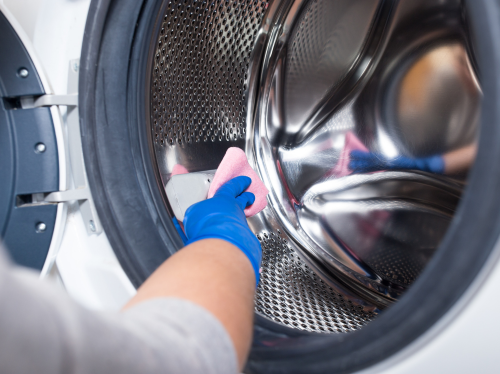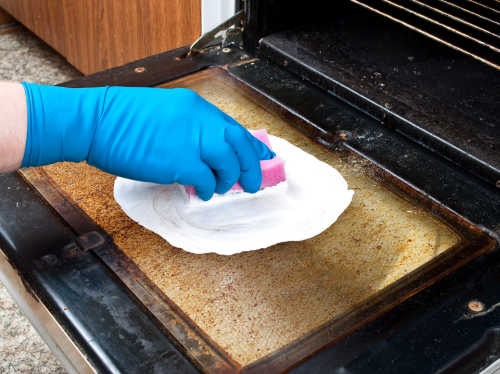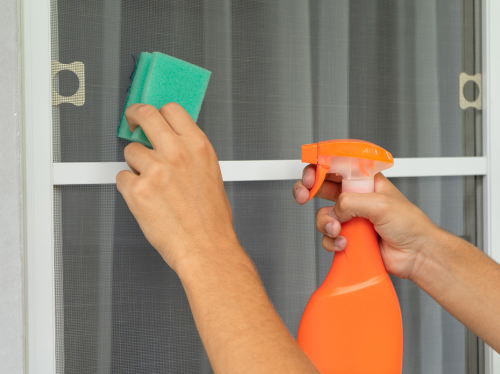Four jobs to give your house a deeper clean this spring
Four jobs to give your house a deeper clean this spring
As the weather warms up and we open up our homes more, it might feel like a good time for a bit of a deeper clean. (Especially when that extra light coming in catches the dust on your ceiling fans and flyscreens!)
But who wants to spend a whole day cleaning? Particularly if the sun happens to be shining.
Here are four jobs you can tackle bit by bit, in smaller windows of time, to get your house really clean. And a bonus is a couple of these can help extend the life of your big (and expensive) appliances.
For anywhere you're dealing with dust, it's important to wear an appropriate face mask while cleaning to protect your airways.
When you've got 30 minutes or less: Wipe down your ceiling fans
You don't have to do them all at once — just do whatever you can fit in your time window.
You'll need a step ladder, vacuum, a cloth with some soapy water and a sheet to protect beds, furniture or surfaces under the fan from dust.
Experts advise to start by vacuuming any loose dust from the fan's surfaces.
"Otherwise [you're] just going to spread the dirt further, turn it into mud and it's going to be harder to clean."
It's a good idea to vacuum the fan's blades to remove any loose dust before using cleaning cloths.
You don't need to use any fancy cleaning products to wipe the remaining dust from the fan blades; a mixture of warm, soapy water and a regular household cloth will do the job.
30 minutes to an hour free: Give your washing machine some love
Not cleaning your washing machine can result in a build-up of mould, scum and grime in and on your machine, as well as rust. This can affect how well the machine cleans, cause it to smell bad and may also end up on your clothes.
Keeping your washing machine door ajar after each use and wiping down the seal will help keep mould at bay.
The outside of the machine, the detergent drawer and the rubber door seal can all be wiped using a soft cloth and warm soapy water.
Remove and clean the filter, using a towel and/or tray to catch the water which will run out. Extract any hair, lint or objects from the filter then rinse, using a soft brush if needed to get it clean.
To clean the drum, it's as easy as running an empty cycle or cleaning cycle with hot water and a little detergent or washing machine cleaner. And if you regularly use a hot cycle for clothes, you can probably skip this step.
Lastly, check hoses for any blockages or leaks is essential.
Ongoing maintenance: Following these steps every few months will keep your washing machine clean. Leaving the door ajar between uses will also help avoid mould and look after the door seal, and not using fabric softener will reduce build-up, making future cleans easier.
Got a couple of hours? Tackle your oven
The first thing to do when it comes to your oven is look at the instruction manual to check if it has a self-cleaning function, in which case you should follow the instructions and let it do its thing, then just wipe out the ash.
If you're not lucky enough to have that as an option, use the manual to get familiar with where all the elements and features are in your oven and what to remove before you clean.
Then you can use an oven cleaner product. "Then you just wipe it out."
To combat grease build up it's best to give your oven a wipe down after use.
Going forward: The easiest way to avoid having to do big cleans of your oven is to wipe it down after cooking anything greasy. We recommends using a microfibre cloth with oven cleaner products.
A morning or afternoon available: Clean your screens
Check if your screens can be removed and make sure you know how and from what side to remove them. Otherwise you could do some costly damage.
If they are not removable or you are not confident in removing them, he says a soft brush (like the one from a dustpan and broom) will deal with surface dust and spider webs, but a microfibre cloth or mitt and warm soapy water will give a better clean.
Microfibre cloths can help clean fly screens and doors experts say.
You can hose them down, using a soft brush to clean off the dust. Or use a small pressure washer. Just make sure the pressure is not so strong it will damage anything, and that the glass is closed behind them before you start.
If you can remove your screens, taking them outside for a wash can make things easier, make sure you label which screens belong to which windows for when you need to put them back in.
For more information on any products or ways to get the job done contact our team.





